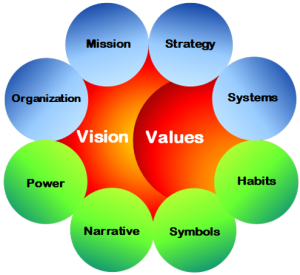Defining the Cultural Ecosystem
The Dynamic Culture Model
Based in part upon the work of Professors Edgar Schein, Gerry Johnson, Kevan Scholes and several others, ACTADVISORY has developed a user-friendly model of organizational culture that defines the cultural ecosystem and has proven useful in efforts to effect positive culture change as part of its CultureDYNAMICS program.
The model introduces the components—called Dynamics—of organizational culture generally considered common to all organizations, and facilitates a sense of the interactivity among the various Dynamics, ultimately promoting understanding of how organizational cultures develop and function. This baseline insight is essential to any effort to change or improve the culture.
The cultural Dynamics are divided into three categories:
Core Dynamics: Vision and Values—the non-negotiable cultural prerequisites that define the organization—its existential Purpose and ethos
Organizing Dynamics: Organization Structure, Mission, Strategy and Systems & Processes—the cultural elements designed to establish the mechanisms perceived necessary to the realization of the organizational Vision
Organic Dynamics: Informal Power Structures, Narrative & History, Symbols, and Habits—the generally informal cultural attributes that develop and evolve over time, most often not by conscious design, and flesh out the character of the organization in subtle but critical ways.
These ten Dynamics are depicted as spheres in the model below. Collectively they define the ecosystem or Culture unique to each organization. Note that the Vision and Values—the Core Dynamics—lie at the center or heart of the model. We think of these as constituting the existential Purpose and Ethos—the Paradigm, if you like—of the enterprise, and providing the foundation for organizational leadership. They are surrounded by the Organizing Dynamics, depicted in blue, which can be considered the ‘management tools’ necessary to the realization of the organizational Vision, and the Organic Dynamics, shown in green. These are the cultural elements that develop naturally over time, starting with the founding of the enterprise. They generally do not arise from conscious effort, and they are by far the most difficult organizational attributes to change.
We see this model as three- dimensional and fluid—existing in the perpetual motion of evolution. Envision the blue organizing and green organic spheres as constantly moving in random patterns around the solid core dynamics—frequently binding to one or more of the other spheres, occasionally bouncing off each other, but always moving; never static. This provides a degree of visual insight into our idea of a genuinely Dynamic Culture—one in which the concept of continuously adapting, adjusting, improving is so deeply ingrained it ultimately becomes the norm, the routine, the paradigm.
dimensional and fluid—existing in the perpetual motion of evolution. Envision the blue organizing and green organic spheres as constantly moving in random patterns around the solid core dynamics—frequently binding to one or more of the other spheres, occasionally bouncing off each other, but always moving; never static. This provides a degree of visual insight into our idea of a genuinely Dynamic Culture—one in which the concept of continuously adapting, adjusting, improving is so deeply ingrained it ultimately becomes the norm, the routine, the paradigm.
The model is intended to provide a visual reference in understanding the ecosystem that is organizational culture generally, and a useful tool in assessing and planning the unique culture of any given enterprise specifically. The model should not be considered a ‘roadmap’, but rather a compass to assist in navigating the sometimes-treacherous shoals of cultural transformation.
For further information:
